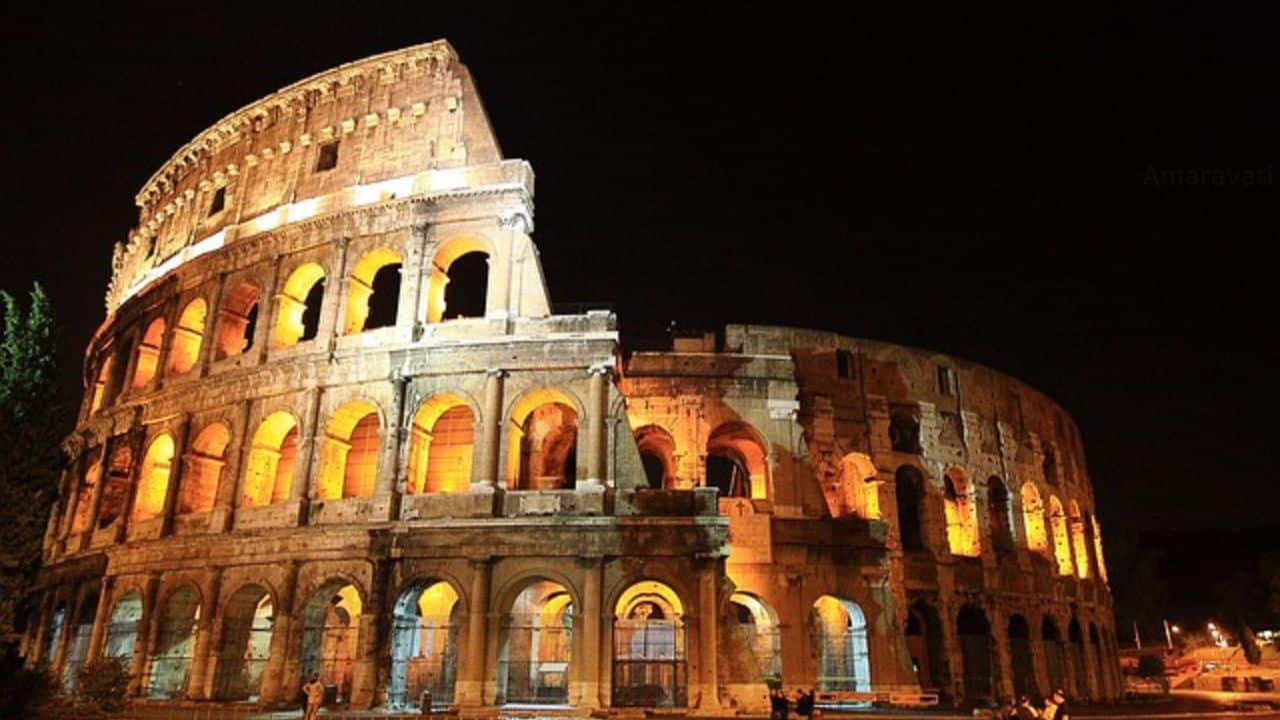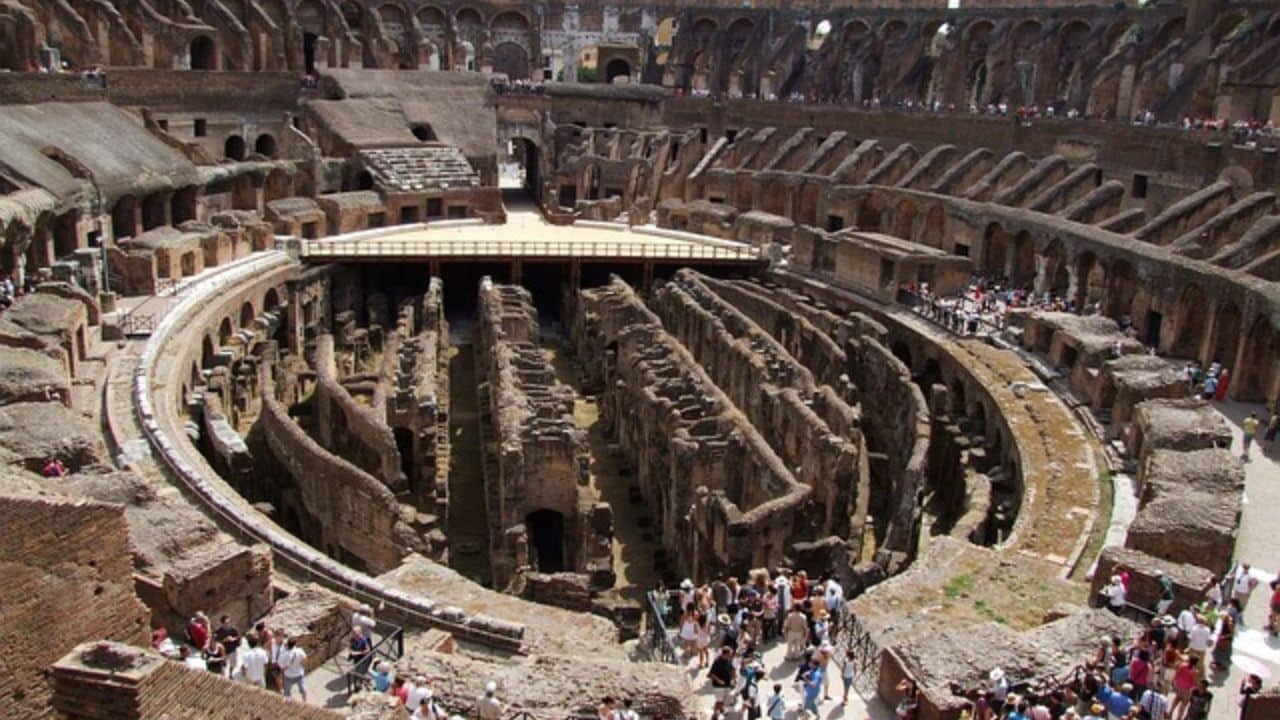Imagine a giant oval building in the heart of Visiting the Colosseum in Rome Italy that could seat over 50,000 people! That’s the Colosseum, an amazing structure built almost 2,000 years ago. Back then, it was a place for exciting and sometimes scary shows, like battles between gladiators and wild animals. Today, it’s a famous landmark that people travel from all over the world to see.

Where is the Colosseum located?
The Colosseum is located smack dab in the centre of Rome, Italy. If you were looking at a map of Rome, it would be right in the middle of the city, just east of another ancient site called the Roman Forum.
The Colosseum is located in which country?
The Colosseum is located in Italy. It’s one of Rome’s most popular tourist attractions, a city with a very long and interesting history.
Colosseum History
The Colosseum, the Flavian Amphitheatre, is a giant entertainment building in Rome, Italy. Here’s a quick look at its history:
- Building it Big: Construction began around 70-72 AD by Emperor Vespasian and was finished by his son, Titus, in 80 AD. They even made some changes later!
- Entertainment Extravaganza: The Colosseum was the place to be for exciting shows. People loved watching gladiatorial battles, where skilled fighters duelled each other. They also had animal hunts, plays, and even fake sea battles with water filling the arena!
- Big Crowds, Big Fun: The Colosseum was enormous, made of stone and concrete and could seat 50,000 people. Imagine the cheers and roars of the crowd!
- The End of the Games: The Colosseum wasn’t used for shows after the Roman Empire fell. Over time, earthquakes and weather damaged it.
- A Lasting Legacy: Today, the Colosseum is a popular tourist spot. It’s a reminder of the engineering skills of the Romans and the kind of entertainment they enjoyed.

Why is the Colosseum broken?
The Colosseum looks broken today for a few reasons, all happening after the Roman Empire ended. Here’s the breakdown:
- No more upkeep: Once the Roman Empire fell apart, nobody cared for the Colosseum. Imagine a giant building without roof repairs or cleaning for hundreds of years! Things started to fall apart.
- Earthquakes: Over time, some strong earthquakes in Rome damaged the Colosseum, especially in the 14th century, and brought down a large section.
- Borrowed building blocks: People in later times saw the Colosseum as a giant pile of ready-made building materials! They took stones and metal from the Colosseum to build churches, palaces, and other things. This left big holes and gaps in what we see today.
So, even though it’s partly broken, the Colosseum is still an impressive reminder of how amazing Roman engineering was! Visiting the Colosseum in Rome Italy

Colosseum Italy tickets
The Colosseum is incredible, but you’ll need tickets to get inside. Here’s the scoop:
Buy Tickets Online: This is almost always the best option. Tickets sell out fast, especially during peak season.
Types of Tickets: There are a few options:
Regular Ticket: This lets you explore the inside of the Colosseum (not the arena floor) and gives you entry to the Roman Forum and Palatine Hill (ancient ruins next door).
Special Access Tickets: Want a closer look? Some tours offer access to the arena floor where the gladiators fought.
Skip the Line: Tickets often have a designated entry time to avoid long lines.
Where to Buy: There are a few official sellers online. You can search for “Colosseum official tickets” to find them.
Tip: Be sure to book your tickets well in advance, especially if you’re travelling during the busy summer months Visiting the Colosseum in Rome Italy
Places to visit near the Colosseum in Rome
Ancient Rome:
Roman Forum: The Roman Forum was the beating heart of ancient Rome. Imagine a giant outdoor complex that was like a combination of a marketplace, a courthouse, and a religious centre. Here, Romans would come to meet their friends and neighbours, buy and sell goods, vote in elections, and celebrate important holidays. You’ll still see the ruins of temples dedicated to Jupiter, Venus, and other Roman gods, arches built to honour victorious emperors, and important buildings like the Senate House, where laws were made.
Palatine Hill: This is where Rome began! It’s a park with amazing city views, offering a glimpse into the lives of powerful emperors. Imagine strolling through palaces once decorated with frescoes and statues and hearing the echoes of history beneath your feet. Here, you’ll find the ruins of the Domus Flavia, a complex of palaces built by emperors of the Flavian dynasty, including the Colosseum itself. Another highlight is the House of Livia, Augustus’s wife, one of the best-preserved examples of Roman domestic architecture.
Churches:
Basilica of San Clemente: This church is like a time capsule! Built-in the 4th century on the site of an even older building, the Basilica of San Clemente has layers of history beneath it. Below the main church, you can see the remains of a 1st-century Roman house with frescoes and even a pagan temple dedicated to the god Mithras. Then, explore the ruins of a 3rd-century basilica built on top of the house.
St. Peter’s Basilica: While not exactly a neighbour to the Colosseum, a visit to Rome is only complete with seeing St. Peter’s Basilica. This magnificent church is the centre of the Catholic Church and one of the most important pilgrimage sites in the world. Construction began in the 15th century and took over 100 years to complete. Michelangelo designed the dome, one of Rome’s most iconic landmarks. Inside the basilica, you’ll find stunning artwork, including sculptures by Michelangelo and Bernini. Take advantage of the opportunity to climb to the top of the dome for breathtaking views of Rome.
Other Interesting Places:
Trevi Fountain: This stunning fountain is one of the most popular tourist attractions in Rome. Legend has it that if you toss a coin into the Trevi Fountain, you’ll be guaranteed a return trip to Rome. Toss the coin with your right hand over your left shoulder! The tradition of throwing coins into the Trevi Fountain began in the 17th century, and today the money collected is used for charity.
Spanish Steps: A popular spot for people to watch and climb the stairs for great views of the city below. The Spanish Steps are a monumental staircase consisting of 135 steps, built between 1723 and 1726 to link the Bourbon Spanish Embassy to the Trinità dei Monti church at the top. At the bottom of the stairs, you’ll find the Piazza di Spagna, a bustling square, a great place to relax and soak up the atmosphere. The Spanish Steps are adorned with colourful flowers during the spring and summer, making them an even more photogenic spot. Visiting the Colosseum in Rome Italy
FAQS
Who was killed in the Colosseum?
We don’t know exactly who died in the Colosseum, but estimates say it could be thousands over many years. Gladiators, criminals, and wild animals all met their end here. There’s also a popular belief that Christians were killed there, but evidence suggests this wasn’t very common.
What is the real name of the Colosseum?
The Colosseum has two names! The most common one we use today is the Colosseum. But its original name was the Flavian Amphitheater, which the Flavian emperors built.
What is the secret of the Colosseum?
The Colosseum’s biggest secret lies beneath its floor! A hidden network of tunnels (called the hypogeum) housed gladiators, animals, and scenery. Surprises would burst into the arena through trapdoors, keeping the crowds on the edge of their seats!
What is the death gate in the Colosseum?
The Colosseum didn’t have a “death gate.” There were many entrances, but one exit on the west side was called the “Gate of Death” because it’s where they carried away dead gladiators and animals after fights. If you visit today, you can walk through it yourself!
Why is the Colosseum a seventh wonder?
The Colosseum is a seven wonder because it’s an amazing feat of engineering for its time. It’s huge, with seating for 50,000 people, and it was built almost 2,000 years ago! It stands as a symbol of Roman power and the cleverness of their architects.
Read More:
Goa to Gokarna Distance & Budget Travel Guide
Distance from Kathgodam to Kainchi Dham
Leh to Nubra Valley Distance & Budget Travel Costs
Manali to Leh Distance & Budget-Friendly Travel Tips
